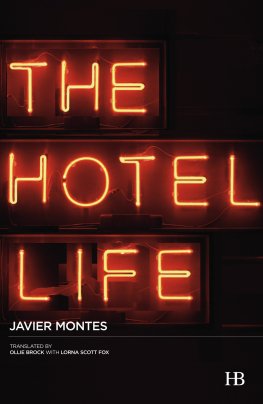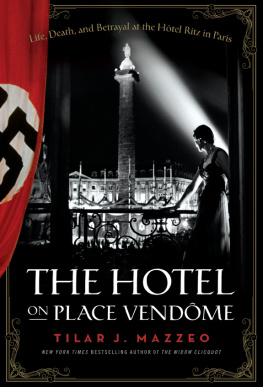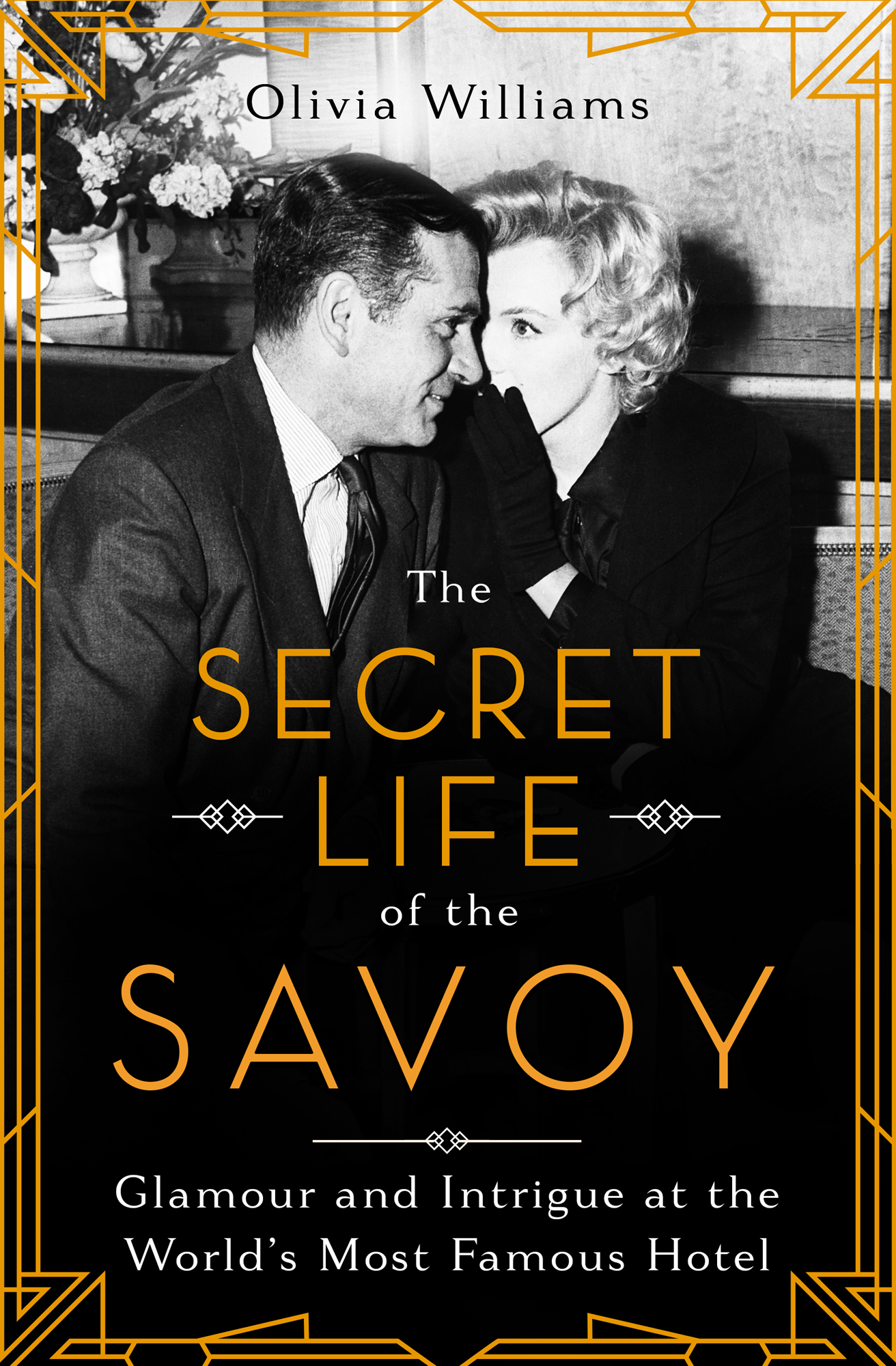CONTENTS
Guide
Olivia Williams
The Secret Life of the Savoy
Glamour and Intrigue at the Worlds Most Famous Hotel
Also by Olivia Williams:
GIN GLORIOUS GIN: How Mothers Ruin Became the Spirit of London
THE SECRET LIFE OF THE SAVOY
Pegasus Books, Ltd.
148 West 37th Street, 13th Floor
New York, NY 10018
Copyright 2021 by Olivia Williams
First Pegasus Books cloth edition June 2021
Front cover photograph Hulton-Deutsch Collection/CORBIS/Corbis via Getty Images.
Art Deco flourishes Shutterstock
All rights reserved. No part of this book may be reproduced in whole or in part without written permission from the publisher, except by reviewers who may quote brief excerpts in connection with a review in a newspaper, magazine, or electronic publication; nor may any part of this book be reproduced, stored in a retrieval system, or transmitted in any form or by any means electronic, mechanical, photocopying, recording, or other, without written permission from the publisher.
ISBN: 978-1-64313-738-4
Ebook ISBN: 978-1-64313-739-1
Distributed by Simon & Schuster
www.pegasusbooks.com
For my late father, and my late friend, Georgie
The function of the Savoy is to make people happy, to get rid of the problems of life. We all have them.
Sir Hugh Wontner,
chairman of the Savoy Hotel (194884) and of the Savoy Theatre (194892)
INTRODUCTION

Fantasy worlds were the stock in trade of the DOyly Carte family. They were, at their height, the greatest impresarios and hoteliers in the world. With their Savoy Theatre and Savoy Hotel, which take up nearly an acre of central London, they pioneered a luxurious form of escapist socialising. Their name became a household term, at first as the impresarios behind Gilbert and Sullivan. Starting in the 1870s, they took these unprecedently popular light operas on tours to America, Europe, Asia and Africa, year-in, year-out, from their base on the Strand. On stage they conjured early modern Venice in The Gondoliers, commissioned a real Arcadian babbling brook for Patience, and the tiny bulbs that they embedded in fairies costumes for Iolanthe gave us the term fairy lights. They then applied this stagecraft to creating one of the worlds earliest luxury hotels, next door to the theatre, putting it together with the same flair and glossy precision as their theatrical productions.
Their Savoy Hotel became a microcosm of a newly diverse local and international elite, who came to be wined and dined and entertained, and, as the DOyly Cartes grasped intuitively, to see and be seen. Wherever guests had arrived from, the aim was to create a sense of belonging and excitement for them. I gravitated towards the family not only because I liked that they made the city a more romantic, sociable place, but also because I liked them. They were not successful in a detached, failsafe way; they were a little eccentric and too emotional to be truly businesslike. I became as curious about the things that went wrong for them as the things that went right.
During a century of almost surreal change and upheaval, from the 1880s, when their theatre and hotel opened, to the 1980s, when their line ended, their resistance to any kind of standardisation served them well. The Savoy was a city in itself, staff liked to say they did things differently there.
Following on from the familys Victorian patriarch, Richard DOyly Carte, his son and then his granddaughter took up the mantle. As though casting for one of their productions, they thought about how to keep a cosmopolitan mix of illustrious people coming back again and again to the hotel. Ailing aristocrats were offered cheaper rooms to keep them in the game, artistic types could come for the prix fixe rather than the full-blown restaurant menu, while the super rich could book out whole floors and make outlandish banqueting demands as they saw fit. Tycoons were kept in touch with Wall Street with a ticker tape charting the movement of the markets, couples seeking discretion were offered private entrances, and the hotel press office organised photo shoots and interviews for celebrities in the comfort of their suites. All sorts of needs were catered for, in the hope of keeping all sorts of guests happy.
So, if the Savoy and its creators are so special, why has no one written their story before? It has only really become possible with the passage of time. During the DOyly Cartes reign at the Savoy, the hotel board worried that the familys personal lives would not reflect well on the business, so they repeatedly brushed off biography offers. For their part, the family themselves were content to operate behind the scenes without recognition. Their name has accordingly lost the resonance it once had as they fade further and further into the past.
Whether privately troubled or not, high achievers often yearn to have their lives recorded, however. Aristotle Onassis, a Savoy regular, who makes an appearance in this book, is a case in point. He enthusiastically commissioned his own biography, despite his often dubious behaviour. For nearly a year he had a journalist listening to his self-aggrandising anecdotes, plying him with champagne, not letting him go to bed, and then dragging him to breakfast at Claridges, the Savoys smaller sister hotel, to carry on talking about himself having spent all night doing exactly that.
The DOyly Cartes took the opposite approach. They gave only a handful of interviews in over a century of prominence. Beyond their most immediate confidantes and friends, few people knew them well. Among a small group, they were generous and trusting. They wrote blank cheques for certain employees to use while they were abroad, left others money in their wills, and invited household staff to make use of their houses in their absence. Outside that circle, however, most found them secretive, and wondered what they had to hide. It resulted in persistent rumours, including the suggestion that the hotel laundry was being used as a place to squirrel away personal documents, far from the rest of the management, where no one would think to look.
Towards the end of her life, the last DOyly Carte, Bridget, started burning papers herself, and had others unceremoniously emptied into skips. Perhaps the staff theory about secrets had some truth or perhaps, if she had been in a happier state of mind by then, and more confident about her legacy, she may not have wanted to clear some of it away. The only reason we have some documents now is that staff found their disposal a shame and fished them out of the skips again.
Taking their lead from the family, staff across the various DOyly Carte enterprises took their work admirably seriously, which drew me into the wider story of the hotel and theatre.
Paolo Contarini, the Savoys former head of banqueting, who worked there from 1945 until his retirement in 1971, wrote an elegiac book about his time there. In his memoir, The Savoy was my Oyster, he brought his learned reading to bear on his hotel work, quoting Dante, Shakespeare and gastronome Jean Anthelme Brillat-Savarin, but, in this intellectual approach, he was not unusual among his colleagues. The Savoy management speeches at shareholders meetings were peppered with Biblical and classical references, Latin phrases and word play, while front-of-house staff were expected to read the daily newspapers to understand their guests lives better, ensuring they would be ready to hold informed conversations with anyone who walked in through the polished doors.








